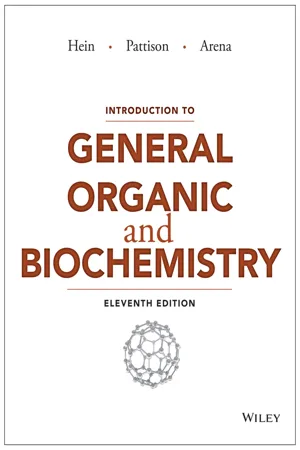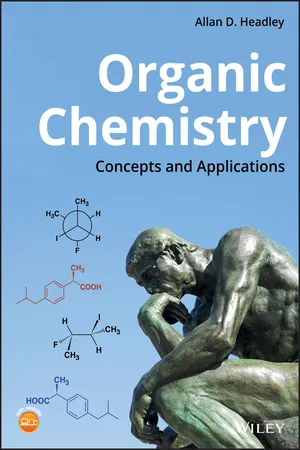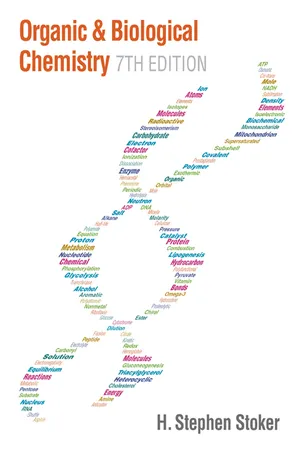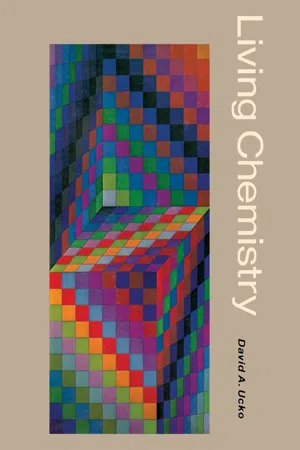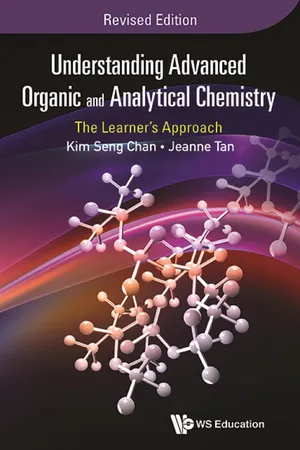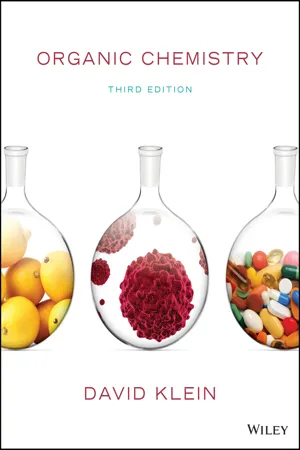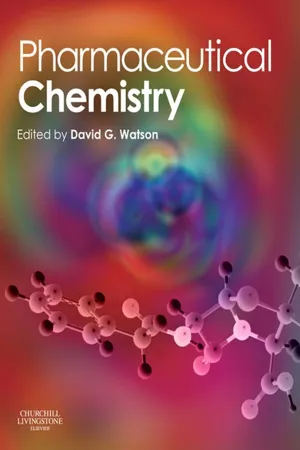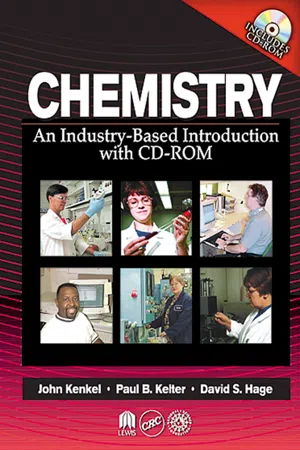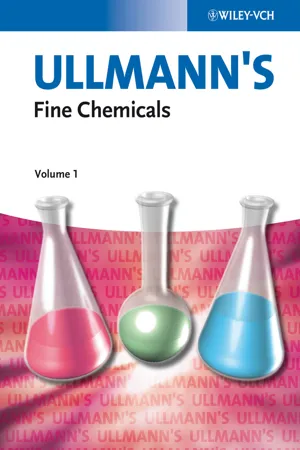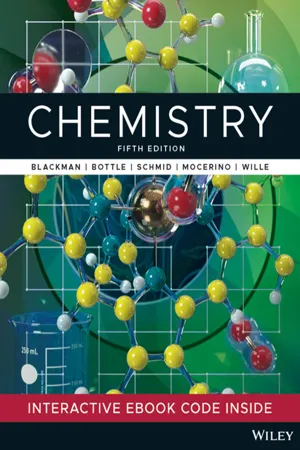Chemistry
Alcohols
Alcohols are organic compounds characterized by the presence of a hydroxyl (-OH) group attached to a carbon atom. They are commonly used as solvents, antiseptics, and in the production of beverages and pharmaceuticals. Alcohols can be classified as primary, secondary, or tertiary based on the number of carbon atoms bonded to the carbon atom bearing the hydroxyl group.
Written by Perlego with AI-assistance
Related key terms
1 of 5
11 Key excerpts on "Alcohols"
- Morris Hein, Scott Pattison, Susan Arena, Leo R. Best(Authors)
- 2014(Publication Date)
- Wiley(Publisher)
22.4 CHEMICAL PROPERTIES OF Alcohols Write equations to illustrate the typical reactions of Alcohols. An alcohol contains the hydroxyl functional group ( i OH). Chemists have chosen the term functional group to indicate that this group brings a “function” to an organic molecule. Just as adding new electronic chips to a calculator adds new functions, attaching a hydroxyl group to an alkyl chain allows a molecule to function in new ways. As we have seen, the i OH group interacts with water so that when a molecule adds a hydroxyl group, its solubility in water increases. In general, the “functions” of a hydroxyl group help determine the properties of an alcohol. Acidic and Basic Properties Aliphatic Alcohols are similar to water in their acidic/basic properties. If an alcohol is mixed with a strong acid, it will accept a proton (act as a Brønsted–Lowry base) to form a protonated alcohol or oxonium ion: CH 3 OH � H 2 SO 4 CH 3 O � H H � HSO 4 � Alcohols also can act as Brønsted–Lowry acids. Methanol and ethanol have approximately the same acid strength as water, while the larger Alcohols are weaker acids than water, reflecting the properties of the longer alkanelike carbon chains. Both water and Alcohols react with alkali metals to release hydrogen gas and an anion: sodium hydroxide H 2 O � 2 Na 2 Na � 2 � OH � H 2 sodium ethoxide CH 3 CH 2 OH � 2 Na 2 Na � 2 � OCH 2 CH 3 � H 2 (g) (g) KEY TERMS oxonium ion alkoxide ion Saytzeff’s rule condensation reaction LEARNING OBJECTIVE 22.4 • Chemical Properties of Alcohols 545 The resulting anion in the alcohol reaction is known as an alkoxide ion (RO - ). Alkoxides are strong bases (stronger than hydroxide), and so they are used in organic chemistry when a strong base is required in a nonaqueous solution. The order of reactivity of Alcohols with sodium or potassium is primary 7 secondary 7 tertiary. Alcohols do not react with sodium as vigorously as water.- eBook - PDF
- David R. Klein(Author)
- 2021(Publication Date)
- Wiley(Publisher)
530 CHAPTER 12 Alcohols and Phenols DO YOU REMEMBER? Before you go on, be sure you understand the following topics. If necessary, review the suggested sections to prepare for this chapter. • Brønsted–Lowry Acidity (Sections 3.3–3.4) • Designating the Configuration of a Chiral Center (Section 5.3) • Mechanisms and Curved Arrows (Sections 6.8–6.11) • Substitution and Elimination Reactions of Alcohols (Section 7.10) Take the DO YOU REMEMBER? QUIZ in the online course to check your understanding. 12.1 Structure and Properties of Alcohols Alcohols are compounds that possess a hydroxyl group (OH) connected to an sp 3 -hybridized car- bon atom, and are characterized by names ending in “ol”: OH Ethanol Cyclopentanol OH A vast number of naturally occurring compounds contain the hydroxyl group. Here are a couple of examples: HO H H H H Cholesterol Plays a vital role in the biosynthesis of many steroids HO H H Cholecalciferol (vitamin D 3 ) Regulates calcium levels and helps to form and maintain strong bones Phenol is a compound that exhibits an OH group connected directly to a phenyl ring. Substituted phenols are extremely common in nature and exhibit a wide variety of properties and functions. The following are just two examples: OCH 3 OH N H O Capsaicin The compound responsible for the spicy hot flavor of chili peppers OH O Tetrahydrocannabinol (THC) The psychoactive drug found in marijuana (cannabis) OH Phenol H H Nomenclature Recall that four discrete steps are required to name alkanes, alkenes, and alkynes: 1. Identify and name the parent. 2. Identify and name the substituents. 3. Assign a locant to each substituent. 4. Assemble the substituents alphabetically. Alcohols are named using the same four steps and applying the following rules: • When naming the parent, replace the suffix “e” with “ol” to indicate the presence of a hydroxyl group: Pentane Pentanol OH - eBook - ePub
Organic Chemistry
Concepts and Applications
- Allan D. Headley(Author)
- 2019(Publication Date)
- Wiley(Publisher)
3 Heteroatomic Functional Groups and Organic Nomenclature3.1 Properties and Structure of Alcohols, Phenols, and Thiols
Alcohols have the ─OH functional group, and Alcohols are very important compounds in organic chemistry and today’s economy. Alcohols that have three or less carbons are some of the most common Alcohols. Methanol, which has one carbon, is often used as an alternate fuel for the internal combustion engines. It is a desirable alternative fuel since its combustion is very efficient. It is typically combined directly with gasoline but can be used directly as is the case with some racing cars. Methanol can typically be oxidized to form formaldehyde and formic acid, which are compounds that are used widely in industry. Ethanol has two carbons and is also used as a blend in combination with gasoline for fuel. It is also the alcohol of alcoholic beverages. Since pure ethanol is a strong dehydrating agent, it cannot be consumed directly. Alcoholic liquids, such as whiskey, are mixtures of ethanol and water, and the typical mixture is in the range of 45–50% in ethanol/water by volume. The term proof is an old terminology, which refers to the alcoholic content of an alcoholic mixture and is defined as twice the percentage of alcohol by volume; thus, for example, a 50% alcohol solution, is also referred to as 100 proof. A major health disadvantage in the use of ethanol is that it is oxidized rapidly and can result in cirrhosis of the liver. On the other hand, methanol, which has a very similar structure to ethanol, is toxic to the body; it damages the optic nerve, which results in blindness, so it should never be consumed. Ethylene glycol, another alcohol that has two ─OH groups, is the main component of antifreeze/coolant. Owing to the low vapor pressure, very high boiling point (197 °C), and very low freezing point (−13 °C) of ethylene glycol, it remains a liquid even in the most severe winter and summer weather. Interestingly, propylene glycol, another alcohol that has two ─OH groups, is used in small amounts in the food and cosmetic industries, whereas ethylene glycol is poisonous. Another important alcohol is isopropanol, which is also known as rubbing alcohol. Isopropanol has many household and personal care uses, and it is also used in industry as a solvent. - eBook - PDF
- H. Stephen Stoker(Author)
- 2015(Publication Date)
- Cengage Learning EMEA(Publisher)
Copyright 2016 Cengage Learning. All Rights Reserved. May not be copied, scanned, or duplicated, in whole or in part. Due to electronic rights, some third party content may be suppressed from the eBook and/or eChapter(s). Editorial review has deemed that any suppressed content does not materially affect the overall learning experience. Cengage Learning reserves the right to remove additional content at any time if subsequent rights restrictions require it. 3-3 Nomenclature for Alcohols 83 Alcohols may be viewed structurally as being alkyl derivatives of water in which a hydrogen atom has been replaced by an alkyl group. H H O O O Water R H O O O An alcohol Figure 3-2 shows the similarity in oxygen bond angles for water and CH 3 ! OH, the simplest alcohol. Alcohols may also be viewed structurally as hydroxyl derivatives of alkanes in which a hydrogen atom has been replaced by a hydroxyl group. R ! H R ! OH An alkane An alcohol Alcohols in which the hydroxyl group is attached to a ring of carbon atoms (a cycloalkyl group) rather than a chain of carbon atoms (an alkyl group) also exist. Two such compounds are OH OH CH 3 CH 3 CH 2 CH 3 CH 2 CH 2 Two-carbon alcohol One-carbon alcohol Three-carbon alcohol OH OH OH Figure 3-1 Space-filling models for the three simplest unbranched-chain Alcohols. Water (H–OH) ~105˚ One-carbon alcohol (CH 3 –OH) ~109˚ Figure 3-2 A comparison of the molecular shapes of water and the one-carbon alcohol (the simplest alcohol). This simplest alcohol may be viewed structurally as an alkyl derivative of water. 1. The alcohol functional group, ! OH, is called the a. hydroxide group b. hydroxyl group c. hydroxide ion d. no correct response 2. The simplest alcohol possible contains how many hydrogen and oxygen atoms, respectively? a. 1 and 1 b. 2 and 1 c. 4 and 1 d. no correct response 3. Which of the following statements concerning Alcohols in incorrect ? a. They may be viewed as alkyl or cycloalkyl derivatives of water. - eBook - PDF
- David Ucko(Author)
- 2012(Publication Date)
- Academic Press(Publisher)
Figure 11-5 is a chart containing esters and other oxygen derivatives d e -scribed in this chapter. SU T h e oxygen atom can b e c o m b i n e d with a hydrocarbon in the form of several functional groups. These groups determine to a large degree the properties o f the resulting molecule. Alcohols contain the hydroxyl group, — O H , connected to a hydrocarbon group. T h e simplest alcohol is methanol, or methyl alcohol, C H 3 O H . T h e c o m p o u n d known simply as a l c o h o l is generally ethanol, or ethyl alcohol, C H 3 C H 2 O H . R u b b i n g alcohol c o m p o u n d is 2-propanol, or isopropyl al-cohol. Other important Alcohols include menthol, phenol, ethylene glycol, hexylresorcinol, and glycerol. T h e alcohol can b e converted to other oxygen-containing groups b y oxida-tion. In organic chemistry, oxidation generally involves the addition of oxygen or removal of hydrogen from a molecule. Alcohols also undergo dehydration, the removal of water. Ethers are organic molecules that contain an oxygen atom covalently b o u n d to two hydrocarbon groups. Diethyl ether, or simply ether, C H 3 -C H 2 O C H 2 C H 3 , is an important anesthetic. Other ethers include divinyl ether, eugenol, and ethylene oxide (an epoxide). Ethers are relatively stable chemically but can oxidize to form explosive peroxide compounds. Aldehydes contain a carbonyl group —c— attached to a hydrogen atom at one end and a hydrocarbon group at the other. a ter en der at es t e dr ar ns Methanal, or formaldehyde Ο H C H is the simplest aldehyde. Tests for aldehydes, using Benedict's, Fehling's, or Tollen's solution, are based on the ability of aldehydes to act as reducing agents, b e c o m i n g oxidized (to acids) in the process. Ketones have a carbonyl group attached at both ends to hydrocarbon groups, as in propanone (dimethyl ketone) or, more commonly, acetone. - eBook - ePub
Understanding Advanced Organic and Analytical Chemistry
The Learner's ApproachRevised Edition
- Kim Seng Chan, Jeanne Tan;;;(Authors)
- 2016(Publication Date)
- WS EDUCATION(Publisher)
CHAPTER 8
Alcohols and Phenol
8.1 Introduction
Water, H—O—H, is a molecule that is capable of forming hydrogen bonds, and the hydrogen atom is only acidic enough to react with reactive metals, such as sodium, to liberate hydrogen gas. This acid– metal reaction is a characteristic property of an acid, provided the acid is indeed acidic enough to react with the metal. What does it mean? Water is not acidic enough to react with zinc, but hydrochloric acid is. Thus, if one uses zinc metal to determine whether water is an acid or not, then water would fail the acidic test. Other characteristic properties, if they can be observed, include reaction with a carbonate/hydrogencarbonate to give off carbon dioxide gas and reaction with a base to give salt and water. Again, note that an acid may not demonstrate all three characteristics at the same time.If one of the hydrogen atoms of the H−O−H molecule is replaced by a sp3 hybridized carbon atom, one would get a homologous group of organic molecules known as alcohol. These compounds have physical and chemical properties similar to that of water. Alcohols, usually abbreviated as ROH, are organic compounds that contain the hydroxyl functional group, which is basically an −OH group bonded to a C atom. They have the general formula Cn H2n+1OH. The following structure shows the dipoles that are being created in an ethanol molecule due to the more electronegative oxygen atom.Q:Can we replace both the hydrogen atoms of the H—O—H molecule with carbon atoms?A:Certainly! We would get a class of compound known as ether, which has the C—O—C functional group. Ether is a functional group isomer of alcohol, and it shares the same molecular formula, Cn H2n+2 O, as alcohol. Notice that the C:H ratio of both the alcohol and ether are same as alkane, Cn H2n+2 - eBook - PDF
- David R. Klein(Author)
- 2016(Publication Date)
- Wiley(Publisher)
Small Alcohols (methanol, ethanol, propanol) are miscible with water. A substance is said to be soluble in water when only a certain amount of the substance will dissolve in a specified volume of water at room temperature. Butanol is soluble in water. SECTION 12.2 • The conjugate base of an alcohol is called an alkoxide ion. • The pK a for most Alcohols falls in the range of 15–18. • Alcohols are commonly deprotonated with either sodium hydride (NaH) or an alkali metal (Na, Li, or K). • Several factors determine the relative acidity of Alcohols, including resonance, induction, and solvating effects. • The conjugate base of phenol is called a phenolate, or phenoxide ion. SECTION 12.3 • When preparing an alcohol via a substitution reaction, pri- mary and secondary substrates will require S N 2 conditions, while tertiary substrates will require S N 1 conditions. • Addition reactions that will produce Alcohols include acid- catalyzed hydration, oxymercuration-demercuration, and hydroboration-oxidation. SECTION 12.4 • Alcohols can be formed by treating a carbonyl group ( C = O bond) with a reducing agent. The resulting reaction involves a decrease in oxidation state and is called reduction. • LiAlH 4 is more reactive than NaBH 4 . For example, LiAlH 4 will reduce carboxylic acids and esters, while NaBH 4 will not. SECTION 12.5 • Diols are compounds with two hydroxyl groups. • Diols can be prepared from diketones via reduction using a reducing agent. • Diols can also be made via syn dihydroxylation or anti dihy- droxylation of an alkene. SECTION 12.6 • Grignard reagents are carbon nucleophiles that are capable of attacking a wide range of electrophiles, including the car- bonyl group of ketones or aldehydes, to produce an alcohol. • Grignard reagents also react with esters to produce Alcohols with introduction of two R groups. - eBook - ePub
- David G. Watson(Author)
- 2011(Publication Date)
- Churchill Livingstone(Publisher)
This is really a generalisation, it is probably truer to say that where oxygen-containing groups play an important role in conferring pharmacological activity they have a very specifically targeted function. In contrast, the charged nitrogen atom exerts a more general effect and may affect a number of targets. This theme will be expanded later in the chapter. Water is the fundamental oxygen-containing biologically active substance and some of its unique properties have been discussed in Chapter 1. The 3-D structure of water is shown in Figure 5.1. The geometry is more or less tetrahedral with the lone pairs occupying two of the corners of the tetrahedron and the two protons the other two. The lone pairs in water lie in a deeper energy well (highest occupied molecular orbital [HOMO] −12.4 eV) than the lone pair in ammonia (HOMO −10.4 eV). In the case of ethanol, the energy well occupied by the most accessible lone pair is slightly shallower at −11.2 eV, indicating that Alcohols are slightly more basic than water and conversely water is a stronger acid than Alcohols. Water can function both as a weak acid and a weak base as indicated in Figure 5.2. Figure 5.1 3-D structure of water and ethanol. Figure 5.2 Ionisation of water. Monohydric Alcohols The lower Alcohols are liquids with low boiling points. Methanol, ethanol and propanol are all miscible with water but n-butanol is only soluble 1 part in 10 in water and amyl alcohol is immiscible with water. If the surface area of the hydrocarbon chain of the alcohol is decreased, then water solubility will increase. Thus the order of water solubility for the primary, secondary and tertiary butyl Alcohols is: t-butanol > butanol-2-ol > n-butanol (Fig. 5.3); t-butanol is freely soluble in water. The properties of some Alcohols are shown in Table 5.1. Figure 5.3 Primary, secondary and tertiary Alcohols. Table 5.1 Some monohydric Alcohols Formula Name b.p - eBook - PDF
Chemistry
An Industry-Based Introduction with CD-ROM
- John Kenkel, Paul B. Kelter, David S. Hage(Authors)
- 2000(Publication Date)
- CRC Press(Publisher)
6.7 Organic Compounds Containing Oxygen As stated previously, oxygen, nitrogen, and other elements can be a part of the structure of organic compounds. The organic compounds containing oxygen is the largest group and warrants division into several classifications. These include functional groups and compounds that may be familiar to you. We will take a close look at the six groups shown in Fig. 6.4. To facilitate an organized look at these classifications, we will utilize an abbreviation that will allow us to focus on the functional group itself and to help represent a general picture of each classification. This abbreviation is called an R-group . An R-group represents a hydrocarbon grouping, or any organic grouping of elements. The functional group containing oxygen will be shown attached to it. The R-group may be a simple group, such as a methyl group, but it may also represent something much more complicated. In some cases it may represent a hydrogen. As we proceed through our study of the classifications, we will encounter some of the other relatively simple examples discussed in Section 6.6.1. These are the ethyl group, the n-propyl group, and the isopropyl group. 6.7.1 Alcohols Let us begin with the Alcohols. The functional group for Alcohols is the “ –OH” group. Using the R-group representation, the general alcohol structure would be: The common system for naming Alcohols is and the formal IUPAC naming system is based on the name of the alkane with the same number of carbons where the “e” at the end of the name of the alkane is dropped and replaced with “ol.” Here are the simplest Alcohols and their names. Methanol is also known as “wood alcohol” because it can be distilled from wood. It is the major ingredient in automobile windshield washer fluid and is the automobile gasoline additive (under several different trade names) that helps car engines to start in cold weather. - eBook - ePub
- (Author)
- 2014(Publication Date)
- Wiley-VCH(Publisher)
Alcohols, Polyhydric Peter Werle, Degussa AG, Hanau-Wolfgang, Germany Marcus Morawietz, Degussa AG, Hanau-Wolfgang, Germany Stefan Lundmark, Perstorp Specialty Chemicals AB, Sweden Kent Sörensen, Perstorp Specialty Chemicals AB, Sweden Esko Karvinen, Perstorp Oy, Porvoo, Finland Juha Lehtonen, Perstorp Oy, Porvoo, Finland1. General Aspects
The properties common to all polyhydric Alcohols are determined by the hydroxyl groups: hydrogen bonding leads to high boiling points, high viscosity, and solvency for polar substances. Other important characteristics are the structure of the Alcohols and the accessibility of the hydroxyl groups (primary, secondary, or tertiary), which influence the chemical behavior and the thermal stability of the hydroxyl functions. Alcohol groups next to a neo structure (e.g., pentaerythritol or neopentyl glycol) exhibit higher resistance towards elimination and degradation because of the lack of β-hydrogen atoms. Some of the important physical properties of the Alcohols discussed in this article are given in Table 1 .Table 1. Physical properties of polyhydric Alcohols.Important reactions of polyhydric Alcohols are those with isocyanates to form urethanes, with acids and acid anhydrides to form esters, and with aldehydes or ketones to form acetals or ketals.Polyhydric Alcohols, especially triols and tetrols, are normally regarded as polyols, but in the literature poly(ether alcohol)s such as poly(ethylene glycol)s and/or poly(ester alcohol)s are sometimes also classified as polyols.Production. Each class of polyhydric alcohol has its own basic production method and raw materials. The most important synthetic strategies are presented in Scheme 1 - eBook - PDF
- Allan Blackman, Steven E. Bottle, Siegbert Schmid, Mauro Mocerino, Uta Wille(Authors)
- 2022(Publication Date)
- Wiley(Publisher)
Phenols are compounds with one or more hydroxyl groups bonded directly to an aromatic ring. In the previous section we discussed the chemistry of Alcohols (ROH) and here we will introduce the chemistry of phenols (ArOH). Although these functional groups are similar (they both form esters and ethers), they have some important differences, particularly their acidity. Pdf_Folio:968 968 Chemistry We name substituted phenols either as derivatives of phenol or by common names as shown below. OH phenol 3-methylphenol (m-cresol) benzene-1,2-diol (catechol) benzene-1,3-diol (resorcinol) benzene-1,4-diol (hydroquinone) OH OH OH OH OH OH OH Note that benzyl alcohol (phenylmethanol) is not a phenol because the hydroxyl group is not connected directly to the aromatic ring. It is the direct connection of the hydroxyl group to an aromatic ring that gives rise to the different chemical properties of phenols; these will be discussed below. OH benzyl alcohol (not a phenol) Phenols are widely distributed in nature. Phenol itself and the isomeric cresols (o-, m- and p-cresol) are found in coal tar (the liquid distilled from coal in the production of coke). The phenol derivatives thymol and vanillin are important constituents of thyme and vanilla beans, respectively. OH CHO OH OCH 3 4-hydroxy-3-methoxy- benzaldehyde (vanillin) 2-isopropyl-5-methylphenol (thymol) Phenol is a solid with a low melting point and is only slightly soluble in water. In sufficiently high concentrations, it is corrosive to all kinds of cells, because it has a high permeability across the cell membrane and disrupts biochemical processes within the cell. In dilute solutions, phenol has some antiseptic properties and was introduced into the practice of surgery by Joseph Lister, who demonstrated his technique of aseptic surgery at the University of Glasgow School of Medicine in 1865. Nowadays, phenol has been replaced by antiseptics that are more powerful and have fewer undesirable side-effects.
Index pages curate the most relevant extracts from our library of academic textbooks. They’ve been created using an in-house natural language model (NLM), each adding context and meaning to key research topics.
